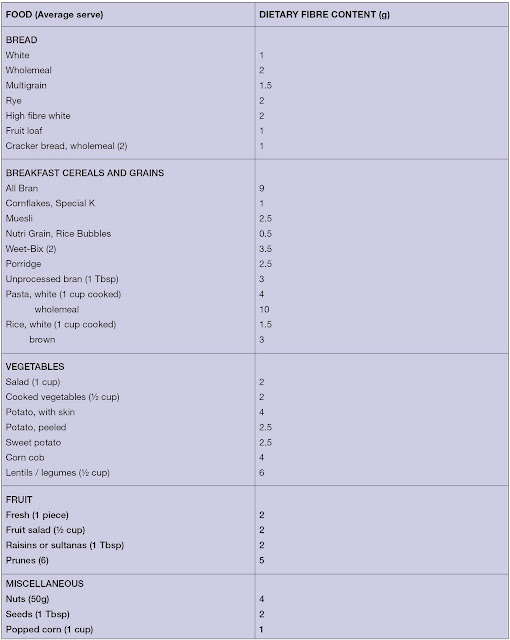There are three main types of fibre:
Water insoluble fibre
Found in fruits, vegetables and wholegrain breads and cereals; this type of fibre adds bulk to your stools. Bulk allows your bowel to push stools through your intestinal tract more easily; reducing constipation and associated problems such as haemorrhoids.
Water soluble fibre
Found in oats, barley, legumes and fruits; this type of fibre slows the emptying of food from the stomach, thereby decreasing hunger. It also helps to reduce blood cholesterol levels (in conjunction with a low fat diet) by inhibiting the production of LDL (bad) cholesterol in your liver.
Resistant starch
Resistant starch can deliver some of the benefits of insoluble and soluble fibre above. It resists digestion and passes through to the large intestine where it acts in a similar manner to dietary fibre. Natural resistant starch is insoluble, fermented in the large intestine and a prebiotic fibre (prebiotic fibres boost beneficial probiotic bacteria in the gut and can decrease the effects of other types of fibre such as gas and bloating). Other types of resistant starch may be soluble or insoluble, and may or may not have prebiotic properties. Sources include cooked navy beans, uncooked banana, cold cooked potato, lentils, cold cooked pasta, pearl barley, cereal and wholegrain bread.
Fibre and Your Diet – so how much should I be having?
For adults, the recommended daily intake of fibre is 30–35 grams; significantly more than the current average intake of 15–20 grams per day. (Please note that children and adolescents’ recommended daily fibre intake is lower than adults’ recommended daily fibre intake). Disorders that can arise from a low fibre diet include constipation, Irritable Bowel Syndrome, Diverticulitis, heart disease and some cancers.
Fibre needs to absorb fluid in your bowel; so if you are consuming the recommended 30 grams of fibre each day, you should drink 2–3 litres of non caffeinated fluids per day. If your fibre intake is greater than 30 grams, your fluid intake will probably need to be greater as well. Without enough water, your stools may be solid and difficult to pass.
If you are currently consuming less than 30-35 grams of fibre each day, we recommend that you increase your fibre intake gradually over the next two weeks. (If you increase your intake too quickly, you are likely to experience abdominal discomfort, bloating and wind as your bowel will not be accustomed to that amount of fibre.) Use the table below (or alternatively your Calorie and Fat Counter) to determine your fibre intake. If necessary, select foods that increase you fibre intake.
* Note that meat, dairy products, eggs, fats and sugars do not contain any dietary fibre.
Who should increase their fibre intake?
Everyone! While everyone should be ensuring adequate quantities of fibre, it is even more important for the elderly as their digestive system tends to slow with age. Fibre is also very important and helpful for diabetics as it slows the glucose absorption from the small intestine into the blood and therefore stabilising blood sugar levels.
Since high fibre foods are typically low in fat, they help to slow the emptying of the stomach and blood sugar levels tend to remain lower. Due to an increase in satiety, a high fibre diet can help people with weight loss, as overall quantity and associated calories tend to be lower.
Top tips for increasing your fibre intake
Below are some simple tips to help with keeping your fibre intake above 30 grams per day:
- Leave skins on fruit and vegetables wherever possible (e.g. potatoes, carrots, cucumber and apples)
- Choose wholemeal or wholegrain breads, rices and pastas
- Choose high fibre breakfast cereals
- Choose fresh fruit instead of juice (dried fruit and canned fruit also have more fibre than juice)
- Use unprocessed bran, wholemeal flour and wholemeal bread crumbs in cooking whenever possible (e.g. in scones, biscuits and schnitzels)
- For snacks, choose high fibre foods (e.g. high fibre cracker biscuits or fruit)
- Add high fibre vegetables to salads (e.g. corn kernels or sweet potato)
- Add legumes to soups, casseroles, salads, pasta sauces and dips.
Legumes can be purchased dried in packets or pre cooked in cans; however the most economical way to purchase legumes is in packets. Dried legumes need to be soaked for 4-24 hours before cooking. After soaking, the water should be discarded and the legumes should be rinsed to remove the ‘flatus factors’ (wind producing substances). Canned legumes have already gone through this process, but it is still advisable to rinse them well before use.

No comments:
Post a Comment